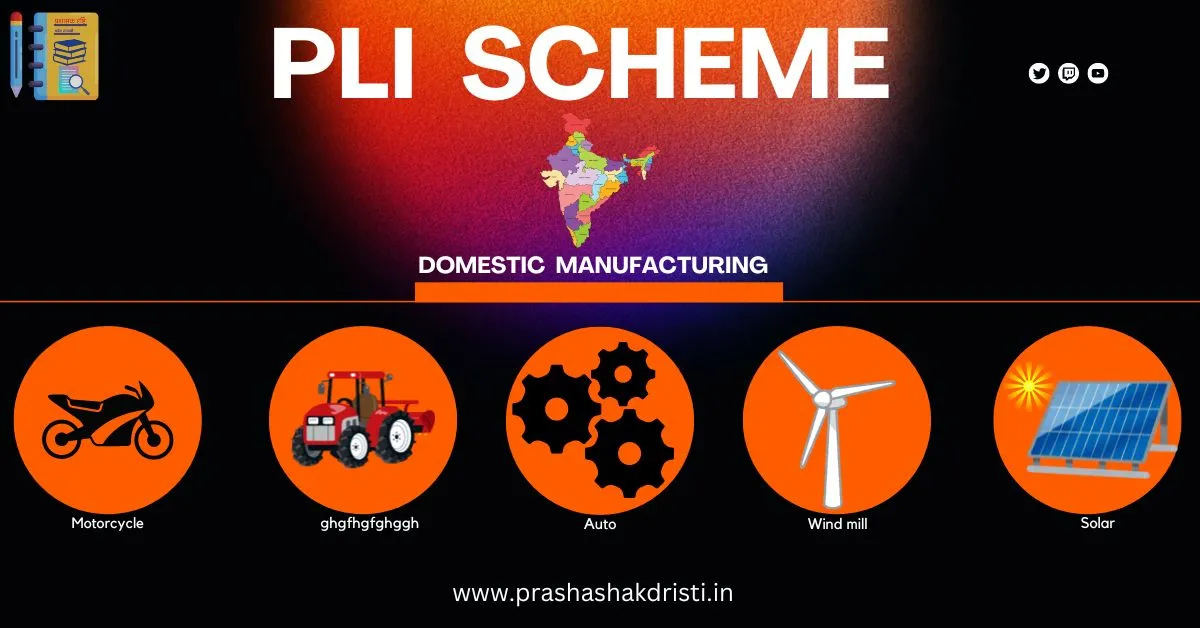The Production Linked Incentive scheme (PLI) is a policy introduced by the Government of India. It aims to boost domestic manufacturing and attract foreign investments.
Production Linked Incentive Scheme| PLI Scheme
PLI had Launched in 2020, the PLI scheme is part of India’s Atmanirbhar Bharat initiative. This scheme focuses on key sectors that can drive economic growth and create jobs.

What is the Production Linked Incentive Scheme?
The PLI scheme provides financial incentives to companies. These incentives are based on their production output. The goal is to increase domestic production and reduce imports. The scheme targets sectors with high growth potential. These sectors include electronics, pharmaceuticals, and textiles, among others.
Objectives of the PLI Scheme
The primary objectives of the PLI scheme are:
- Boost Domestic Manufacturing: Increase the production of goods within India.
- Reduce Imports: Decrease dependency on imported goods.
- Create Jobs: Generate employment opportunities in various sectors.
- Attract Investments: Encourage both domestic and foreign investments.
- Enhance Competitiveness: Make Indian products more competitive in the global market.
Key Sectors Under the PLI Scheme
The PLI scheme covers several critical sectors. Each sector has its own set of guidelines and incentives. Here are some of the major sectors included:
- Electronics and IT Hardware: This sector includes mobile phones, laptops, and other IT hardware. The goal is to make India a global hub for electronics manufacturing.
- Pharmaceuticals: This sector focuses on the production of drugs and active pharmaceutical ingredients (APIs). It aims to reduce dependency on imported raw materials.
- Automobiles and Auto Components: The scheme promotes the manufacturing of electric vehicles (EVs) and related components.
- Telecom and Networking Products: This includes the production of 5G equipment and other telecom products.
- Textiles: The scheme encourages the production of man-made fibers and technical textiles.
- Food Processing: This sector focuses on increasing the production and export of processed food items.
- White Goods: The scheme includes the manufacturing of air conditioners and LED lights.
- Specialty Steel: This sector aims to increase the production of high-quality steel.
How Does the PLI Scheme Work?
This scheme works by providing incentives based on incremental sales. Companies must meet specific production targets to qualify for these incentives. The incentives are usually a percentage of the increased sales. This encourages companies to produce more and improve efficiency.
Steps to Apply for the PLI Scheme
Identify Eligibility: Check if your company falls under the eligible sectors.
Prepare Documents: Gather necessary documents such as financial statements and production data.
Submit Application: Apply through the official government portal.
Approval Process: The application is reviewed by the relevant authority.
Claim Incentives: Once approved, companies can start claiming incentives based on their production output.
Benefits of the PLI Scheme
This scheme offers several benefits to companies and the economy:
- Increased Production: The scheme motivates companies to increase their production capacity.
- Cost Reduction: Companies can reduce costs through economies of scale.
- Job Creation: Increased production leads to more job opportunities.
- Technological Advancement: Companies invest in new technologies to improve efficiency.
- Global Competitiveness: Indian products become more competitive in the global market.
The government has approved 755 applications in 14 sectors till March 2024 under the production-related incentive scheme. Under this scheme, an investment of Rs one point two-three (1.23) lakh crore has been made till March 2024. Also, about 8 lakh employment opportunities have been created..
Challenges and Criticisms
While the scheme has many benefits, it also faces some challenges:
- High Entry Barriers: Small and medium-sized enterprises (SMEs) may find it difficult to meet the eligibility criteria.
- Implementation Issues: Delays in the approval process can hinder the scheme’s effectiveness.
- Dependence on Large Firms: The scheme may primarily benefit large firms, leaving out smaller companies.
- Regulatory Hurdles: Complex regulations and compliance requirements can be a challenge.
Success Stories
Several companies have benefited from the PLI scheme. For example:
- Samsung: The electronics giant has increased its production capacity in India.
- Lupin: The pharmaceutical company has expanded its manufacturing facilities.
- Tata Motors: The auto manufacturer is focusing on electric vehicle production.
Future Prospects
The scheme has the potential to transform India’s manufacturing landscape. With continued government support, it can drive significant economic growth. Future expansions of the scheme may include more sectors and higher incentives.
Conclusion
The Production Linked Incentive scheme is a significant step towards making India a global manufacturing hub. By providing financial incentives, the scheme encourages companies to increase production, create jobs, and attract investments. Despite some challenges, the scheme has shown promising results and holds great potential for the future.
Read About – National Apprenticeship Training Scheme (NATS)
Q1: What is the PLI scheme?
Ans:This scheme is a policy by the Government of India to boost domestic manufacturing and reduce imports by providing financial incentives to companies based on their production output.
Q2: Which sectors are covered under the PLI scheme?
Ans: This scheme covers sectors like electronics, pharmaceuticals, automobiles, telecom products, textiles, food processing, white goods, and specialty steel.
Q3: How can companies apply for the PLI scheme?
Ans: Companies can apply for the scheme by identifying their eligibility, preparing necessary documents, submitting an application through the government portal, and then claiming incentives once approved.
Q4: What are the benefits of the PLI scheme?
Ans: The benefits of the scheme include increased production, cost reduction, job creation, technological advancement, and enhanced global competitiveness.
Q5: What are the challenges faced by the PLI scheme?
Ans: Challenges include high entry barriers for SMEs, implementation issues, dependence on large firms, and regulatory hurdles.
Q6: Can you give examples of companies that have benefited from the PLI scheme?
Ans: Companies like Samsung, Lupin, and Tata Motors have benefited from the scheme by increasing their production capacity and expanding their facilities.
Q7: What is the future outlook of the PLI scheme?
Ans: The future prospects of the PLI scheme are positive, with potential for further expansion to include more sectors and higher incentives, driving significant economic growth.
FAQs
A7: The future prospects of the PLI scheme are positive, with potential for further expansion to include more sectors and higher incentives, driving significant economic growth.

